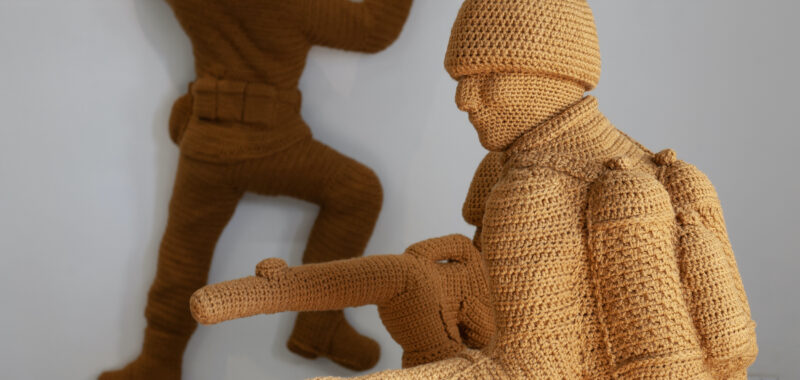LOS ANGELES — The queering of fiber art has inspired artists to produce works that questions and challenges preconceptions of gender through textile materials. With Teach a man to … at Walter Maciel Gallery, Nathan Vincent turns to the traditionally female-gendered fiber arts to knit objects typically associated with men and masculinity, tapping into the viewers’ memories through forms that almost universally resonate.
The artist mines his childhood memories to question what was passed down from his adult influences. Vincent was taught to knit and crochet from female elders who sent mixed messages by simultaneously discouraging the practice. His response as an artist is to soften hard surfaces, such as steel lockers and locks, porcelain urinals, guns, grenades, and bombs.
Vincent subverts masculine tropes in his sculpture series Let’s Play War and large-scale installation “Locker Room” (2011) through scale and texture. Let’s Play War undermines the hypermasculine ideal of the World War II soldier by enlarging toy soldiers to roughly the scale of a child. He renders the soldiers benign by making them smaller than their live counterparts, soft, and approachable, like big sweaters or stuffed toys.

At the same time, the installation underscores the dehumanization of the enemy, coupled with the desensitization of children to violence and war. The scaled-up miniature soldiers lack facial features or any details that would distinguish them as individuals. They are more like faceless NPCs (Non-Player Characters) in a video game than human beings with lives, friends, and families.
The locker room can be both a safe and an unsafe space. The insecurities of adolescence can make early locker-room experiences traumatic. The heavily-enforced gendered space requires strict adherence to a narrow definition of heteronormative behavior.
Yet it could be a platform for budding queer affirmation and desire. For queer men, the locker room became a reclamation of the unsafe space from high school. After most bathhouses in the country were shut down during the height of the AIDS epidemic, the gym became the safe space for the admiration of male bodies in the 1980s and 1990s. For men across the sexuality spectrum, however, the space has been an escape from women, and often a breeding ground for performances of toxic masculinity such as “locker room talk” and hazing.

The locker room is one of the last gendered spaces, which makes it an exclusionary one for bodies that do not adhere to the gender binary, just as the bathroom has long been a battleground for right-wing lawmakers to exclude trans and nonbinary individuals, to force people to fit into these spaces or disappear from public life.
With his work, Nathan Vincent creates simulations of his childhood memories based in safety rather than threat or risk. His sculptures soften the forms that were once used to harden him. He uses scale to reclaim these forms, much like visiting one’s school as an adult and noticing that the desks are small. In doing so, he invites viewers to shift perspective, making room to question what we have been taught as children and what we are passing onto the next generation. It gives us an opportunity to recognize generational curses and find the power to break them.


Nathan Vincent: Teach a man to … continues at Walter Maciel Gallery (2642 South La Cienega Boulevard, Mid-City, Los Angeles) through March 2. The exhibition was organized by the gallery.

